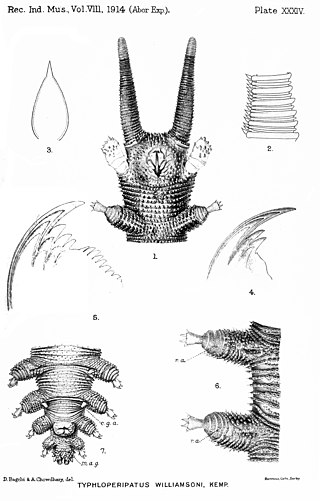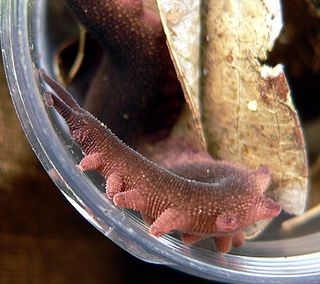
Peripatus is a genus of velvet worms in the Peripatidae family. The name "peripatus" is also used to refer to the Onychophora as a whole, although this group comprises many other genera besides Peripatus. The genus Peripatus is found in Central America, the Caribbean and northern South America. This genus is viviparous, with mothers supplying nourishment to their embryos through a placenta.

Typhloperipatus is a genus of velvet worm in the family Peripatidae, containing the sole species Typhloperipatus williamsoni. This genus is notable for containing the only species in the phylum Onychophora found in South Asia. This species is also striking in that this velvet worm shows no external trace of eyes, although rudimentary optical vesicles are present internally.

Eoperipatus is a genus of velvet worms in the family Peripatidae. These velvet worms have been reported from locations throughout Southeast Asia, including Malaysia, Singapore, Thailand, and Vietnam. This genus exhibits lecithotrophic ovoviviparity; that is, mothers in this genus retain yolky eggs in their uteri.

Oroperipatus is a genus of Neotropical velvet worms in the family Peripatidae. Species in this genus are found in South America west of the Andes and in Mexico. This genus is viviparous, with mothers supplying nourishment to their embryos through a placenta.
Epiperipatus adenocryptus is a species of velvet worm in the Peripatidae family. This species is brown with a series of light brown arcs on each side forming a series of circles down its dorsal surface. Males of this species have 26 or 27 pairs of legs, usually 27; females have 28 to 30, usually 29. The type locality is in Minas Gerais, Brazil.

Epiperipatus brasiliensis is a species of velvet worm in the Peripatidae family. Males of this species have 29 pairs of legs; females have 31 or 33. This species ranges from 37 mm to 80 mm in length. The type locality is in Pará, Brazil. Epiperipatus vagans from Barro Colorado Island (Panama) was originally described as subspecies of Epiperipatus brasiliensis, but is now treated as a full species.
Epiperipatus cratensis is a species of velvet worm in the family Peripatidae. This species is found in northeastern Brazil. These velvet worms range from purple to white. Females of this species have 33 or 34 pairs of legs; males have 30 to 33 pairs.
Epiperipatus diadenoproctus is a species of velvet worm in the Peripatidae family. This species is brown with a series of light brown arcs on each side forming circles down its back. Males of this species have 26 to 28 pairs of legs, usually 27; females have 29 or 30, usually 29. The type locality is in Minas Gerais, Brazil.
Epiperipatus vagans is a species of velvet worm in the Peripatidae family. The male of this species has 29 or 30 pairs of legs; females have 32 or 33. The type locality is in Panama.
Epiperipatus paurognostus is a species of velvet worm in the Peripatidae family. This species is brown with a series of light brown arcs on each side forming circles down its back. Males of this species have 26 or 27 pairs of legs, usually 27; females have 27 to 29, usually 29. The type locality is in Minas Gerais, Brazil.

Epiperipatus edwardsii is a species of velvet worm in the family Peripatidae. Females of this species have 29 to 34 pairs of legs; males have 28 to 30. Females range from 23 mm to 56 mm in length, whereas males range from 25 mm to 30 mm. The type locality is in French Guiana.
Epiperipatus machadoi is a species of velvet worm in the Peripatidae family. This species is dark brown with a series of light brown arcs on each side forming circles down its back and ranges from 20 mm to 66 mm in length. Males of this species have 27 to 29 pairs of legs, usually 28; females have 28 to 31, usually 31. The type locality is in Minas Gerais, Brazil.
Epiperipatus ohausi is a species of velvet worm in the family Peripatidae. Males of this species have 26 to 28 pairs of legs; females have 27 to 29.
Oroperipatus lankesteri is a species of velvet worm in the Peripatidae family. This velvet worm is notable for its large size, reaching 82 mm in length. This species is known only from its type locality in the northern Pacific lowlands of Ecuador.
Mongeperipatus solorzanoi, also known as Solórzano's velvet worm, is a species of velvet worm in the family Peripatidae. This species is the largest known velvet worm, reaching 22 cm in length. This velvet worm is found in the Caribbean coastal forest of Costa Rica.
Epiperipatus beckeri is a species of velvet worm in the family Peripatidae. Females of this species have 28 to 30 pairs of legs. The type locality is in Bahia state in Brazil.
Epiperipatus hyperbolicus is a species of velvet worm in the family Peripatidae. This velvet worm is known only from its type locality in the state of Alagoas in Brazil. The species name refers to the unusually large apical piece on the primary papillae on this velvet worm. This distinctive apical piece is notable for its size and spherical shape. The males of this species have 23 pairs of legs; females have 24 or 25 pairs.
Epiperipatus lucerna is a species of velvet worm in the family Peripatidae. The males of this species have 27 to 29 pairs of legs; females have 29 to 31 pairs. The type locality is in Alagoas state in Brazil.
Epiperipatus marajoara is a species of velvet worm in the family Peripatidae. The males of this species have 27 pairs of legs; females have 31 pairs. The type locality is in Pará state in Brazil.
Epiperipatus titanicus is a species of velvet worm in the family Peripatidae. This velvet worm is known only from its type locality in the state of Alagoas in Brazil. The species name refers to the large size of its females and its numerous legs. This species features more legs than any other Brazilian species of velvet worm.






